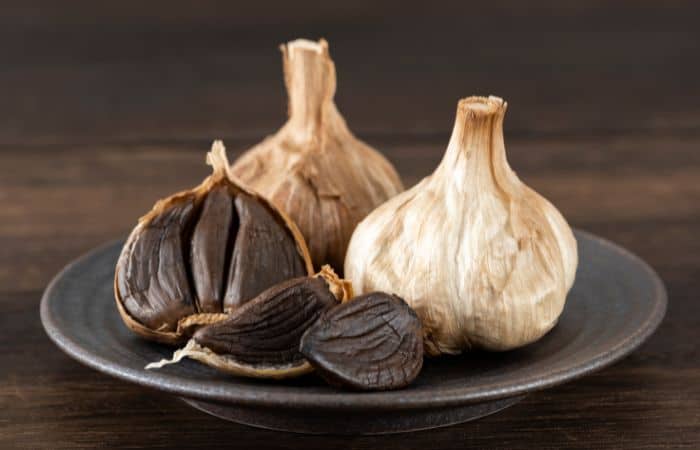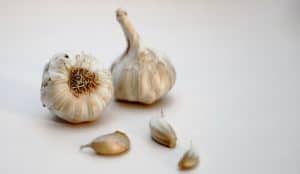Black garlic may not be a common ingredient in the kitchen, but it has been gaining popularity in recent years for its potential health benefits. Unlike regular garlic, black garlic is aged through a fermentation process that transforms the cloves into a soft, sweet, and savory flavor with a unique texture. But, what makes black garlic a superfood? In this blog post, we will explore the health benefits of black garlic and why it should be your next go-to superfood.

What Is Black Garlic, and How Is It Made?
The process of making black garlic involves heating whole bulbs of fresh garlic at a low temperature (usually between 140-170°F or 60-77°C) for a period of several weeks to several months. The garlic is kept in a humidity-controlled environment to prevent it from drying out or spoiling. During this time, the garlic undergoes a chemical transformation as a result of the Maillard reaction, which is a complex chemical reaction that occurs between amino acids and reducing sugars.
As the garlic ages, the Maillard reaction causes a number of changes to take place in the cloves. The garlic turns black, and its texture becomes soft and chewy, similar to that of a dried fruit. The flavor of black garlic is markedly different from fresh garlic, with a sweet, almost caramel-like taste that is often described as having hints of balsamic vinegar or tamarind. Some people also detect notes of molasses, licorice, and even chocolate in black garlic.
The aging process also results in changes to the nutritional composition of garlic. While fresh garlic is already known for its many health benefits, including its antibacterial, antiviral, and anti-inflammatory properties, black garlic contains even higher concentrations of certain compounds, including S-allyl-cysteine (SAC), a powerful antioxidant that is believed to help protect against heart disease and cancer.
Is Black Garlic Nutritionally Superior to Regular Garlic?
Black garlic and regular garlic have similar nutritional profiles, but black garlic does have some nutritional advantages over fresh garlic.
Fresh garlic is already considered to be a nutrient-dense food, containing a range of vitamins, minerals, and other beneficial compounds. One of the most notable of these is allicin, a sulfur-containing compound that is responsible for much of garlic’s health benefits, including its antimicrobial, anti-inflammatory, and cardiovascular benefits.

However, the aging process that black garlic undergoes can increase the concentration of some beneficial compounds in garlic while reducing the concentration of others. For example, the aging process increases the levels of certain antioxidants, such as S-allyl-cysteine (SAC), which has been shown to help protect against heart disease and cancer. In addition, black garlic has a higher concentration of polyphenols, which are known to have anti-inflammatory and antioxidant properties.
On the other hand, the aging process reduces the concentration of some of the volatile compounds that give fresh garlic its pungent aroma and flavor, including allicin. While some of the beneficial compounds in fresh garlic are also present in black garlic, they may be present in lower concentrations due to the aging process.
How Does Black Garlic Taste Differ from Regular Garlic?
The taste of black garlic is markedly different from regular garlic. While fresh garlic has a pungent, spicy, and somewhat bitter flavor, black garlic has a sweet and slightly tangy taste, with hints of caramel and balsamic vinegar. Some people also detect notes of molasses, licorice, and even chocolate in black garlic.
The aging process that black garlic undergoes results in a chemical transformation that changes the flavor profile of the garlic. During the aging process, the natural sugars in the garlic caramelize and break down into new compounds, giving black garlic its characteristic sweet and tangy flavor. The garlic also loses some of its pungency and bitterness as a result of the aging process, which contributes to its unique flavor profile.
Are There Any Potential Side Effects or Risks Associated with Consuming Black Garlic?
Black garlic is generally considered safe for consumption, and there are no known major side effects associated with eating it. However, as with any food, some people may be allergic or sensitive to black garlic, and may experience symptoms such as digestive upset or skin irritation.
There are some precautions to keep in mind when consuming black garlic. Because it is a fermented food, it may contain trace amounts of histamine, which can trigger allergic reactions in some people. Additionally, some people may experience digestive upset or bloating if they consume large amounts of black garlic.
It’s also worth noting that black garlic can be quite potent in flavor, so it’s best to use it in moderation until you become accustomed to its taste and texture.

Overall, black garlic is considered safe for most people to consume in moderation as part of a balanced and varied diet. However, if you have any concerns about consuming black garlic, or if you experience any adverse reactions after eating it, it’s a good idea to talk to your doctor or a registered dietitian.
Can Black Garlic Be Used in The Same Way as Regular Garlic in Cooking?
Yes, black garlic can be used in the same way as regular garlic in cooking, although it is important to note that the two have different flavors, so the amount of black garlic used in a recipe may need to be adjusted accordingly.
Black garlic can be used raw or cooked, and it is a versatile ingredient that can be used in a wide range of dishes, including marinades, dressings, sauces, soups, stews, and roasted or grilled meats and vegetables.
When using black garlic in cooking, it is important to keep in mind that it is much softer and stickier than fresh garlic, and it can be a bit messier to work with. To use black garlic, simply peel away the papery outer layer and chop or mince the cloves as desired.
Because black garlic has a milder, sweeter flavor than fresh garlic, it is often used as a flavor enhancer in dishes where the strong flavor of fresh garlic might be overpowering. Some people also enjoy eating black garlic as a snack on its own, or spread on toast or crackers.
Conclusion
Black garlic may not be a household name yet, but it’s worth considering as your next go-to superfood. With its unique taste and texture and numerous potential health benefits, it’s a versatile ingredient that can be incorporated into various dishes. It’s important to keep in mind the different ways to use black garlic, choose it wisely, and store it properly. By making black garlic a part of your diet, you’ll be on your way to enjoying a healthier and more flavorful life.








